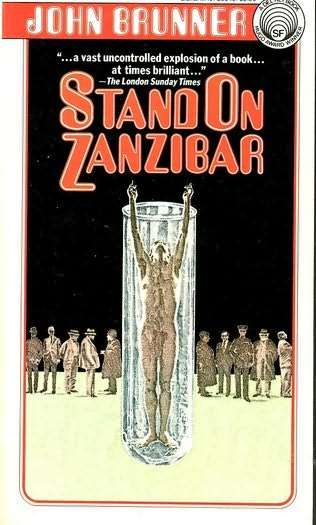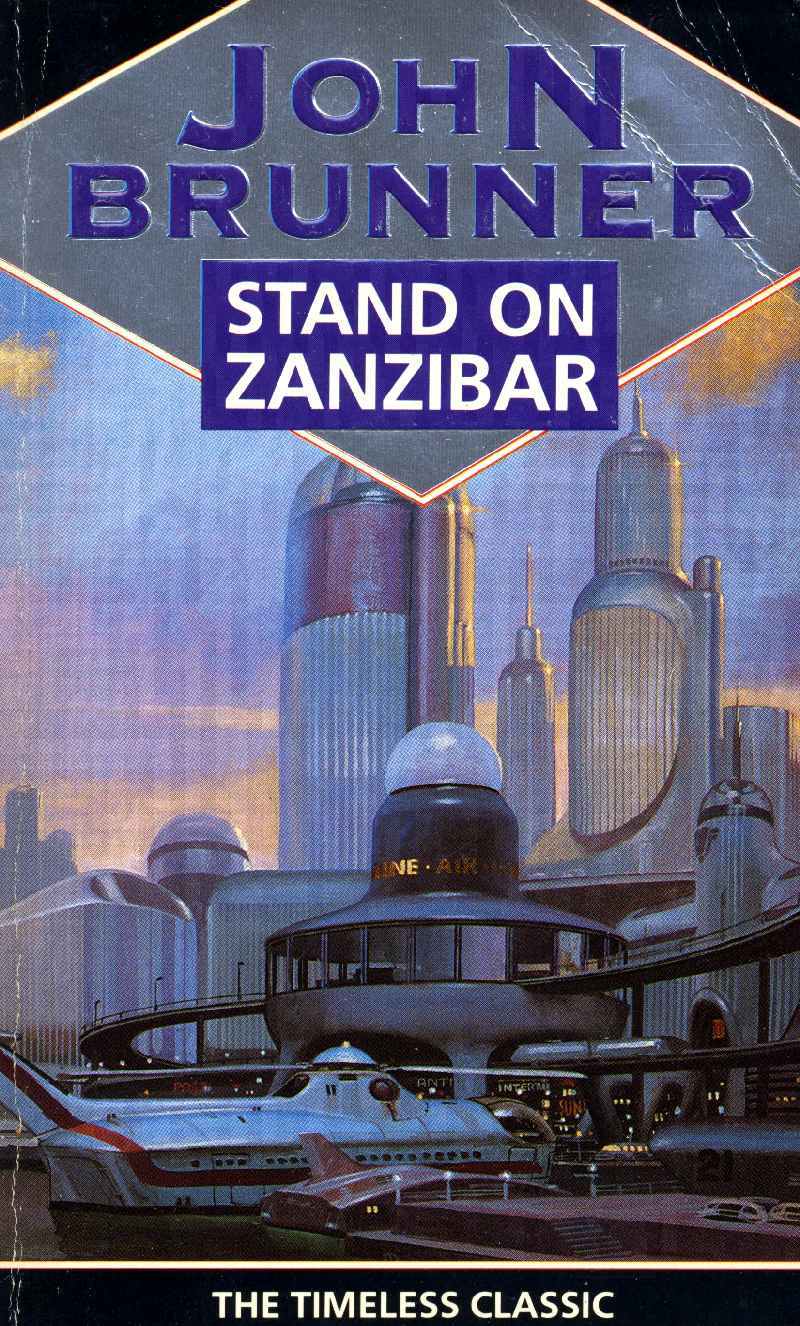It looks like you're using an Ad Blocker.
Please white-list or disable AboveTopSecret.com in your ad-blocking tool.
Thank you.
Some features of ATS will be disabled while you continue to use an ad-blocker.
share:
This is really an odd story that begun back in 1969 when a popular sci-fi novelist, John
Brunner, wrote one of his famous book called "Stand On Zanzibar".
What is interesting in this old novel is that it has many very similar events (political, economical...), characters and technology progress as those nowadays.


John Brunner
Here are some of these incredible predictions:

Source and whole story at: The Millions
I particularly like this sentence from the writer, Ted Gioia:
What is interesting in this old novel is that it has many very similar events (political, economical...), characters and technology progress as those nowadays.

Stand on Zanzibar is set in the year 2010, and this allows us to make a point-by-point comparison and marvel at novelist John Brunner’s uncanny ability to anticipate the shape of the world to come. Indeed, his vision of the year 2010 even includes a popular leader named President Obomi.

John Brunner
Here are some of these incredible predictions:
(1) Random acts of violence by crazy individuals, often taking place at schools, plague society in Stand on Zanzibar.
(2) The other major source of instability and violence comes from terrorists, who are now a major threat to U.S. interests, and even manage to attack buildings within the United States.
(3) Prices have increased sixfold between 1960 and 2010 because of inflation. (The actual increase in U.S. prices during that period was sevenfold, but Brunner was close.)
(4) The most powerful U.S. rival is no longer the Soviet Union, but China. However, much of the competition between the U.S. and Asia is played out in economics, trade, and technology instead of overt warfare.
(5) Europeans have formed a union of nations to improve their economic prospects and influence on world affairs. In international issues, Britain tends to side with the U.S., but other countries in Europe are often critical of U.S. initiatives.
(6) Africa still trails far behind the rest of the world in economic development, and Israel remains the epicenter of tensions in the Middle East.
(7) Although some people still get married, many in the younger generation now prefer short-term hookups without long-term commitment.
(8) Gay and bisexual lifestyles have gone mainstream, and pharmaceuticals to improve sexual performance are widely used (and even advertised in the media).
(9) Many decades of affirmative action have brought blacks into positions of power, but racial tensions still simmer throughout society.
(10) Motor vehicles increasingly run on electric fuel cells. Honda (primarily known as a motorcycle manufacturers when Brunner wrote his book) is a major supplier, along with General Motors.
(11) Yet Detroit has not prospered, and is almost a ghost town because of all the shuttered factories. However. a new kind of music — with an uncanny resemblance to the actual Detroit techno movement of the 1990s — has sprung up in the city.
(12) TV news channels have now gone global via satellite.
(13) TiVo-type systems allow people to view TV programs according to their own schedule.
(14) Inflight entertainment systems on planes now include video programs and news accessible on individual screens at each seat.
(15) People rely on avatars to represent themselves on video screens — Brunner calls these images, which either can look like you or take on another appearance you select — “Mr. and Mrs. Everywhere.”
(16) Computer documents are generated with laser printers.
(17) A social and political backlash has marginalized tobacco, but marijuana has been decriminalized.

Source and whole story at: The Millions
I particularly like this sentence from the writer, Ted Gioia:
Certainly, there are many details, large and small, that Brunner got wrong. But even when the particulars don’t ring true, the overarching theme of Stand on Zanzibar, which is the hidden cost of our obsession with human perfectibility, is just as relevant today as when Brunner wrote his novel.
edit on 9-4-2013 by elevenaugust because: (no reason given)
I will be buying this book, if its truly this accurate, I want to see what else the author wrote. Maybe some insight into some clairvoyance.
Thanks again for bringing this to my attention
Fox
Thanks again for bringing this to my attention
Fox
Just amazing! It reminds me how science-fiction often influences, and in this case predicts, the future. Arthur C. Clarke of course contributed to the
invention of satellite technology and to some degree, artificial intelligence. It also surprises me that Stand on Zanzibar is not required
reading in some schools, when Aldous Huxley's "Brave New World" is. I especially liked the "President Obomi" part. I wonder what else this book
has that can related to current geopolitics that hasn't been picked up yet.
reply to post by elevenaugust
Thank you so much for posting this!
I don't really have much to add since I haven't read it, but now I do plan on it.
I'm just giving this thread a bump.
Thank you so much for posting this!
I don't really have much to add since I haven't read it, but now I do plan on it.
I'm just giving this thread a bump.
Nice find..
Star and flagged
I will have to locate a copy and read it.
Star and flagged
I will have to locate a copy and read it.
Interesting!!! Thanks. One "sad" thing is that most people can't just run over to their neighborhood used-book store and pick up a copy. Those are
going the way of the nuclear-powered baby buggy. Does anyone know things that Bruner got wrong in the book? (maybe they are "yet to be").
Here's the wikipedia link to "Stand On Zanzibar"
en.wikipedia.org...
I bet alot of the good stuff happens on the talk page (haven't looked at it yet, but things often do get more fun on wikipedia talk pages than on the "real" page itself).
I've convinced the professors at wikipedia to let me copy off a section of the article.
Here's the wikipedia link to "Stand On Zanzibar"
en.wikipedia.org...
I bet alot of the good stuff happens on the talk page (haven't looked at it yet, but things often do get more fun on wikipedia talk pages than on the "real" page itself).
I've convinced the professors at wikipedia to let me copy off a section of the article.
The primary engine of the novel's story is overpopulation and its projected consequences, and the title refers to an early twentieth-century claim that the world's population could fit onto the Isle of Wight; if they were all standing upright. Brunner remarked that the growing world population now required a larger island; the 3.5 billion people living in 1968 could stand together on the Isle of Man (area km2], while the 7 billion people who he (correctly) projected would be alive in 2010 would need to stand on Zanzibar.This figure turned out to be very close to correct. As of June 17, 2010, the U.S. Census Bureau estimates the world population to be 6,827,700,000. Throughout the book, the image of the entire human race standing shoulder-to-shoulder on a small island is a metaphor for a crowded world.
edit on 9-4-2013 by Aleister because: (no reason given)
edit on 9-4-2013 by Aleister because: (no reason given)
Given a certain viewpoint I'm sure quite a few of those points would of been obvious at the time as 1970 isn't as technologically backward time as a
lot of us think
Have a look at his front cover. All wrong 100%
You reading (!) too much into it.
You reading (!) too much into it.
Originally posted by pacifier2012
Have a look at his front cover. All wrong 100%
You reading (!) too much into it.
You can't judge a book by....you know. Anyway, Brunner died in 1995, so he likely didn't design or OK the front cover of the futuristic painting. The guy in the test tube in the OP, maybe he OK'ed that one.
And what's wrong with the second cover? It looks like some modern airports. And have you ever seen Tokyo, or Hong Kong? The future is now.
edit
on 9-4-2013 by Aleister because: (no reason given)
The leaders name is what gets me. A person that reads into this too much might wonder about that. How did the author get so close? Maybe it was all
part of a big plan in the 70's. Just saying.
reply to post by elevenaugust
Certainly interesting but I don’t think his insights were particularly impressive. Perhaps I would have more impressed had his book been authored in 1869 rather that 1969. Surely the man was simply extrapolating on the times he had lived through and the times he was living in. Bearing in mind that most sci-fi writers do make a habit of hanging with the innovators of the modern day be they scientists, anthropologists, sociologists, economists etc. using them to garner information for their latest project. (Aldous Huxley and George Orwell being two renowned authors well known to undertake such practices.)
e.g. From the early 1970’s my father told me that China was the future superpower, and the European Community was on the cards from the end of WWII (actually coming into existence in 1957 – long before Brunner wrote his book)
With regard to people not getting married do remember that 1969 was the height of the hippie movement at a time when society’s values were changing and being rejected en masse by its youth.
The first electric car was invented in 1918
The first video recorders were invented in 1951
Video Recorder
The first satellite (sputnik) was launched in 1957
Sputnik
In 1969 computers were old hat, the first electric programmable computer (Colossus) having been invented in 1943.
Colossus
The first laser printer was invented by Xerox in 1969
Xerox Printer
And so on.
I think Brunner lived in exciting and innovative times and his novel was merely a reflection of that – not foresight.
Certainly interesting but I don’t think his insights were particularly impressive. Perhaps I would have more impressed had his book been authored in 1869 rather that 1969. Surely the man was simply extrapolating on the times he had lived through and the times he was living in. Bearing in mind that most sci-fi writers do make a habit of hanging with the innovators of the modern day be they scientists, anthropologists, sociologists, economists etc. using them to garner information for their latest project. (Aldous Huxley and George Orwell being two renowned authors well known to undertake such practices.)
e.g. From the early 1970’s my father told me that China was the future superpower, and the European Community was on the cards from the end of WWII (actually coming into existence in 1957 – long before Brunner wrote his book)
With regard to people not getting married do remember that 1969 was the height of the hippie movement at a time when society’s values were changing and being rejected en masse by its youth.
The first electric car was invented in 1918
The first video recorders were invented in 1951
Video Recorder
The first satellite (sputnik) was launched in 1957
Sputnik
In 1969 computers were old hat, the first electric programmable computer (Colossus) having been invented in 1943.
Colossus
The first laser printer was invented by Xerox in 1969
Xerox Printer
And so on.
I think Brunner lived in exciting and innovative times and his novel was merely a reflection of that – not foresight.
edit on 9-4-2013 by christina-66 because: (no reason given)
Colour me unimpressed, too. Any sci-fi writer worth his/her salt could have come up with those predictions.
Originally posted by abeverage
Wow that is crazy!
Wait...where is my flying car?
I'm glad we all live in gleaming cylindrical shaped buildings now. Those old square buildings were just too clunky and old-fashioned.
Originally posted by Blue Shift
Originally posted by abeverage
Wow that is crazy!
Wait...where is my flying car?
I'm glad we all live in gleaming cylindrical shaped buildings now. Those old square buildings were just too clunky and old-fashioned.
Most of sci-fi covers portrayed the future as utopian which belied the actual book being a dystopian.
reply to post by abeverage
Blame it on selfish prigs like Dante...
Nice find, OP, will have to look that one up, though a lot of it definitely could be foreseen. I remember telling someone that China would be the new "enemy" back in the early 80s.
Wait...where is my flying car?
Blame it on selfish prigs like Dante...
Nice find, OP, will have to look that one up, though a lot of it definitely could be foreseen. I remember telling someone that China would be the new "enemy" back in the early 80s.
reply to post by adjensen
Meh...Dante and Randal both need a kick to the junk and that stupid sicko German scientist with his foot fetish!
I am actually surprised the future is not shinier...
Meh...Dante and Randal both need a kick to the junk and that stupid sicko German scientist with his foot fetish!
I am actually surprised the future is not shinier...
President Obomi and Mr. and Mrs. Everywhere.
Our parents took this stuff as gospel. Science fiction usually loses the fiction over time.
The author was either a psychic or a prophet, or he had a visitor from the future. A visionary.
Our parents took this stuff as gospel. Science fiction usually loses the fiction over time.
The author was either a psychic or a prophet, or he had a visitor from the future. A visionary.
new topics
-
BIDEN Admin Begins Planning For January 2025 Transition to a New President - Today is 4.26.2024.
2024 Elections: 3 hours ago -
Big Storms
Fragile Earth: 4 hours ago -
Where should Trump hold his next rally
2024 Elections: 7 hours ago -
Shocking Number of Voters are Open to Committing Election Fraud
US Political Madness: 7 hours ago -
Gov Kristi Noem Shot and Killed "Less Than Worthless Dog" and a 'Smelly Goat
2024 Elections: 8 hours ago -
Falkville Robot-Man
Aliens and UFOs: 8 hours ago -
James O’Keefe: I have evidence that exposes the CIA, and it’s on camera.
Whistle Blowers and Leaked Documents: 9 hours ago -
Australian PM says the quiet part out loud - "free speech is a threat to democratic dicourse"...?!
New World Order: 10 hours ago -
Ireland VS Globalists
Social Issues and Civil Unrest: 10 hours ago -
Biden "Happy To Debate Trump"
2024 Elections: 11 hours ago
top topics
-
James O’Keefe: I have evidence that exposes the CIA, and it’s on camera.
Whistle Blowers and Leaked Documents: 9 hours ago, 17 flags -
Australian PM says the quiet part out loud - "free speech is a threat to democratic dicourse"...?!
New World Order: 10 hours ago, 15 flags -
Blast from the past: ATS Review Podcast, 2006: With All Three Amigos
Member PODcasts: 13 hours ago, 13 flags -
Biden "Happy To Debate Trump"
2024 Elections: 11 hours ago, 13 flags -
Ireland VS Globalists
Social Issues and Civil Unrest: 10 hours ago, 9 flags -
Mike Pinder The Moody Blues R.I.P.
Music: 13 hours ago, 8 flags -
BIDEN Admin Begins Planning For January 2025 Transition to a New President - Today is 4.26.2024.
2024 Elections: 3 hours ago, 7 flags -
What is the white pill?
Philosophy and Metaphysics: 13 hours ago, 6 flags -
Shocking Number of Voters are Open to Committing Election Fraud
US Political Madness: 7 hours ago, 6 flags -
Big Storms
Fragile Earth: 4 hours ago, 6 flags
active topics
-
Big Storms
Fragile Earth • 16 • : rickymouse -
James O’Keefe: I have evidence that exposes the CIA, and it’s on camera.
Whistle Blowers and Leaked Documents • 14 • : 19Bones79 -
BIDEN Admin Begins Planning For January 2025 Transition to a New President - Today is 4.26.2024.
2024 Elections • 18 • : rickymouse -
RAAF airbase in Roswell, New Mexico is on fire
Aliens and UFOs • 12 • : pianopraze -
A Warning to America: 25 Ways the US is Being Destroyed
New World Order • 29 • : 19Bones79 -
What is the white pill?
Philosophy and Metaphysics • 22 • : AlexandrosOMegas -
University of Texas Instantly Shuts Down Anti Israel Protests
Education and Media • 315 • : CriticalStinker -
Gov Kristi Noem Shot and Killed "Less Than Worthless Dog" and a 'Smelly Goat
2024 Elections • 58 • : cherokeetroy -
Biden "Happy To Debate Trump"
2024 Elections • 51 • : rickymouse -
Hate makes for strange bedfellows
US Political Madness • 53 • : 19Bones79

